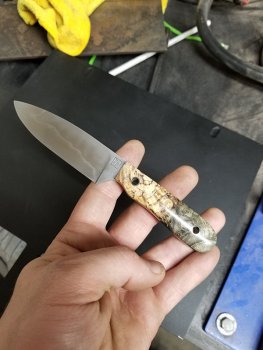There are a LOT of ins and outs with stabilizing, and with stabilized wood/materials. Stabilizing was originally intended to make those materials that would otherwise be unusable.....usable. Things such as "splalted" (another word for rotted)

, or material that would otherwise be too soft or "punky" to use. The misconception quickly formed that stabilizing was a "cure all" to prevent shirking, expansion, etc., and for a while I even thought so..... but after a few years of attempting my own stabilizing, I learned much.
First of all, to achieve durable, long lasting results, you need to use "industrial" grade equipment, the devices and agents that is mostly targeted at knifemakers either simply do not work, or work for a comparatively short time. I came to understand that if you want anything more than a "band-aid", you either need to be willing to spend "big bucks" for industrial grade stabilizing equipment and agents, or the less expensive route is to send the materials to a "professional" stabilizer.
When it comes to materials, the learning curve is long to understand what materials can or cannot be stabilized, and understand those materials that it "sorta" works on.
The short of it is this..... ANY natural material that will shrink or expand, will still do so if stabilized..... depending on the given material, stabilizing may or not minimize the issue(s)....but it will not completely solve it.
Then there is the undesirable characteristics that stabilizing imparts to certain materials....a couple that come to mind is African Blackwood and Koa. With these woods, stabilizing gives the finished product a "cloudy" appearance when compared to the wood in it's natural state.... and this can vary from barely noticeable, to flat out ugly.
Finally, even at the "professional" level, all stabilizing is not created equal. Different stabilizing agents used by different "professionals" yield different results. Time and experience has taught me to send specific materials to specific stabilizers in order to acquire the "best" results.
My personal opinion is that if you want the "best" results/end products, let the "professionals" do it. It's more cost effective, and the results are typically far better than "home brewed" stabilizing. You'll have to be willing to do a LOT of homework to find which stabilizer's process and chemicals work best for given materials, and you'll also want to keep good records of the EXACT number and types of materials you send off..... more than a few times I have been literally ripped off! In one case, I was shorted more then 1/2 the wood blocks I had sent in to a particular stabilizer..... I fought for nearly a year trying to get those blocks, with no success.

